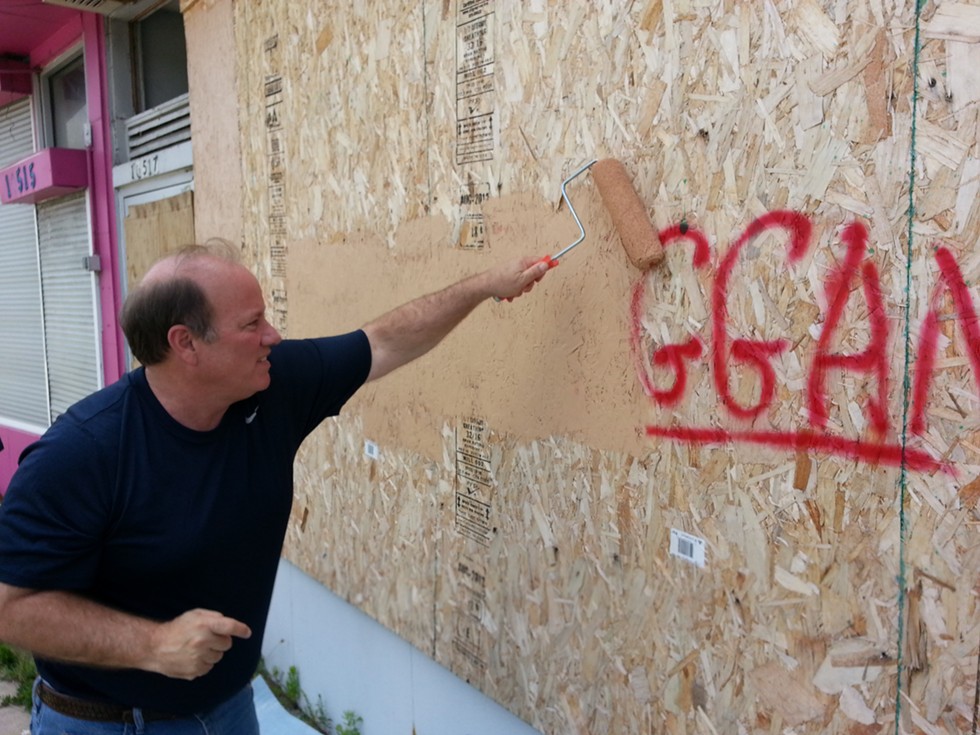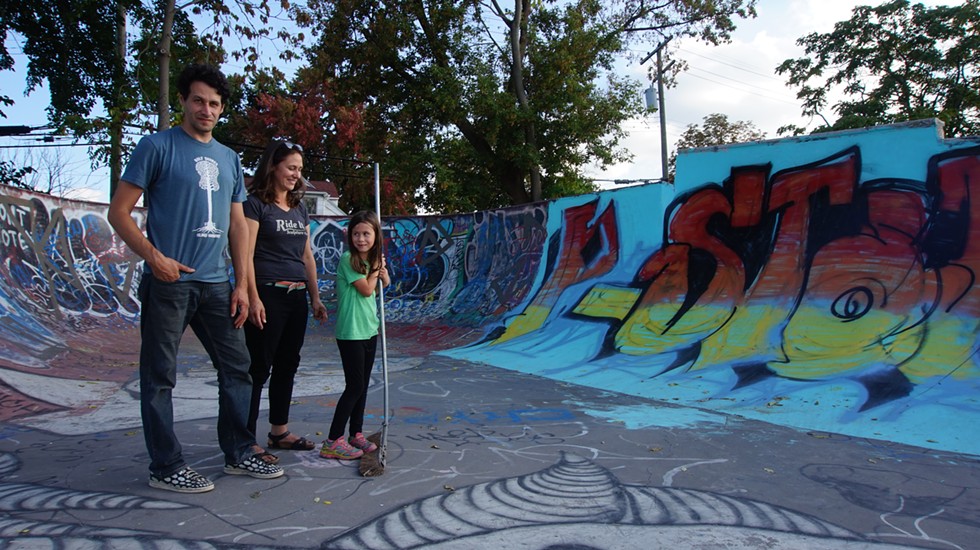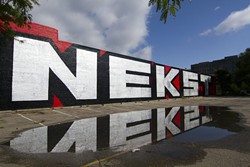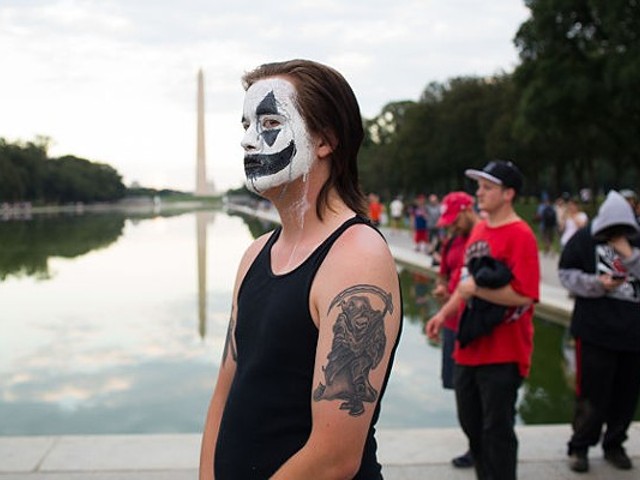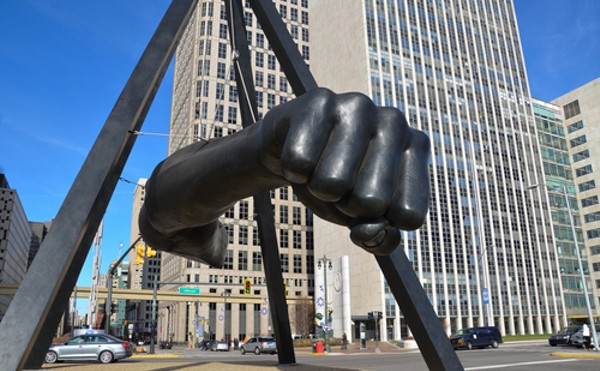There's a turf war going on in Detroit, and you can see its battles playing out on the buildings that line the city's main streets. Though the fight is silent — save for the rattling of a shaken can and the whoosh of its aerosol spray — it can look loud as hell. A patchwork paint job on a corner building on Michigan Avenue depicts a battle hard fought: The graffiti writers came, and the buff man slapped up a coat of magenta paint in an attempt to mask their presence. When the writers returned, the buff man covered their mark again, this time in slate gray. This spray-buff-repeat ritual played out at least five more times — in beige, black, lilac, coral, and teal.
Peeling back the layers of paint reveals the forces at work behind this chaotic scene. On one side are the graffiti writers — an unrelenting, thrill-seeking cohort willing to risk catching felonies to leave a mark that says, "I'm here." On the other is the buff man, Detroit Mayor Mike Duggan — on a mission to make a long-neglected city look like a safe place where people want to live.
Few would argue with the buff man's goal, but his path to attaining it has riled many. Duggan has employed a zero-tolerance approach to graffiti, and in 2014 established a graffiti task force that has not only aggressively gone after the writers, but property owners who fail to clean up their mess. To date, the Duggan administration has issued thousands of graffiti blight tickets, put about a dozen writers behind bars, and spent millions of taxpayer dollars in the process.
And the city has, ultimately, succeeded in its mission to bring things under control. The vibrant, colorful, often stories-high graffiti that once covered Detroit is just about gone, replaced by duller shades of exterior paint.
"Every city kind of has their little (graffiti) heyday, and Detroit's was 2011, 2012, 2013, and 2014," explains a former Detroit graffiti writer who has opted to go by the alias WUZNME313, for fear of having his real tag flagged by police.
In a
The free-for-all came to a near-grinding halt in the wake of Detroit's bankruptcy, when Mayor Mike Duggan assumed control of the city and blight eradication became a priority to which $520 million would be devoted over six years.
But with the vandals now largely curbed and residents who view graffiti as a nuisance mostly satisfied, critics charge the fight hasn't been worth the cost. In addition to making it more difficult for property owners to afford to stay in Detroit, they say the war on graffiti has had unintended consequences for the broader creative
As Vince Carducci, the undergraduate dean at the College for Creative Studies puts it — for the true hipsters, "Detroit is over."
Collateral damage
Mitch Cope's battle with the city began last October, with a ticket taped to a concrete ramp at the community skate park he and his wife operate along Davison near I-75. Internationally-acclaimed artists, the pair have instituted a free-expression policy at the Ride It Sculpture Park, and large, vibrant graffiti pieces have popped up — the markings of some of the bikers,
Cope comes off like a pretty reasonable guy — the kind of person to whom the National Endowment for the Arts and foundations like Kresge and Knight feel comfortable giving large sums of money. So naturally, he figured that as the owner of the property, he could simply tell the powers that be he wanted the graffiti art there.
But when Cope headed down to the Coleman A. Young Municipal Center and found the office of the city employee who would make the call filled with pictures of graffiti — "kind of like an art gallery" — he quickly realized he was dealing with the law, and it wasn't going to bend in the face of artistic nuance.
"I explained to him what we were
Cope refused and has, to date, received three tickets for the graffiti at his park. The inspector who stopped by to issue the latest citation also wrote up an additional $1,000 in tickets for other purported blight violations. Most of the tickets have been dismissed following adjudication hearings, but Cope anticipates there will be more to come. He has obtained a lawyer just in case, dipping into the limited funds he was able to secure for the park in an effort to preserve its intended purpose as a place of free expression.
While his particular case may be more complicated than most, Cope's plight is typical of a Detroit property owner operating in the era of the buff: Since 2014, city records show about 3,900 tickets have been issued for failure "to remove graffiti or restore or maintain property free of graffiti." The fines for such code 9-1-111 violations total more than $1.2 million between ticketing and the cost of graffiti clean up — or more than $300 per violation.
Under the city's graffiti protocol, any marking made on a property without the owner's consent is illegal. But there are also bureaucratic hurdles in place for people who want art on their buildings: Property owners now have to register murals and the like with the city by submitting photos of the work and supplying the names of its creators.
Cope is at a stalemate with Detroit officials because he's refused to give names. Partly, this is because he has no idea who is contributing to the Ride It Sculpture Park — a place where anyone can paint whatever they want whenever they want, as long as it's not offensive. But it's also because some of the graffiti artists who've sprayed there are people the city is trying to hunt down for illegal works they've put up elsewhere.
As he stood before an unwavering officer of the law in the city building last year, down the street from where billionaire Dan Gilbert commissioned a multistory mural by noted street artist Shepard Fairey, Cope couldn't help point out a double standard.
"By your definition, if there's
The conversation quickly devolved into an argument over aesthetics.
"The subjective nature of it all is really a slippery slope," says Cope. "But it was just sort of like me against him, and he was the authority."
Wanted: Art department
Cope's case is just one example of the problems that can arise when rules governing aesthetics are made without any artistic voices in the room.
In 2013, the Museum of Contemporary Art Detroit commissioned a group of graffiti artists to cover the building in a massive red, black, and silver tribute to the prolific graffiti artist NEKST, who had recently died. The pieces, like many in the style of that particular artist, were clean, precise, and, arguably, beautiful. But more importantly, they were
Separately, there was the infamous prosecution of Fairey for the unsanctioned pieces he put throughout the city while he was here working on the mural for Gilbert. In that case, not only did the city spend taxpayer dollars dragging Fairey through court before the case was ultimately tossed by a judge, it went out of its way to remove likely valuable works by an internationally acclaimed artist from abandoned buildings. (And it apparently did so rather cluelessly: A source with knowledge of the situation says the city spent several thousand dollars on a graffiti remover to get rid of Fairey's illegal
"The municipal government hasn't dug too deeply into this to understand what the subtleties are," says Carducci, the undergrad dean at the College for Creative Studies in Detroit. "It's unfortunate, but it's also not surprising. I mean, the law is not particularly enlightened when it comes to these types of questions."
Carducci, Cope, and others in Detroit's arts community say such incidents underscore the critical need for city government to reconstitute the cultural affairs department it lost in 2005. Their cause gained additional attention during the mayoral primary with the candidacy of Afrofuturist art maven Ingrid LaFleur, who made it one of the pillars of her platform.
"We need a full-blown cultural affairs department with a
(The city recently made some progress on the
LaFleur, having had her own run-in with the merciless buff (a gray city services roller job over a work of art a building owner she knows wanted to keep) said during her campaign that, if elected, she would dismantle the graffiti task force and put the money saved toward murals and a cultural affairs division of government.
"[The city is] criminalizing not only the
Whether or not graffiti is "art" is hotly contested. Of course, as with any form of expression, there are distinctions. A small portion of graffiti in Detroit is gang-affiliated — the careless black scrawl of the Seven Mile Bloods or Latin Counts marking their territory. There are no
Zero tolerance
The buff man named Duggan began his erasure mission long before he was elected mayor.
In 2003, while serving as Wayne County prosecutor, he got two out-of-towners locked up for 60 days for spraying an abandoned building, using their court date to stage a press conference in which he likened graffiti writers to animals: "These guys go around, much like a dog marking his territory and urinating on fire hydrants," he said. That same year, Duggan threatened to imprison graffiti writer Turtle, who was known for scrawling the little green reptiles throughout Detroit.
A decade later, while campaigning for the city's top office, Duggan swapped his suit jacket for a black T-shirt and set
"I felt it was so important to deliver a message that we're not going to run a campaign like this, and I wanted to be out here to cover up the first ones myself," he told the media present. He'd cover a half-dozen more "Duggan" tags that day.
These days, many who use graffiti to get their message across don't much like Duggan anymore. Small red, white, and blue stickers in the style of Fairey's famous Obama HOPE poster have appeared around town, instead depicting Duggan's smiling face with the word NOPE underneath. A blue roller tag a couple floors up at an abandoned factory reads Duck
The posts are scarce, however, as social media has become a liability in the era of the buff. Police use platforms like Instagram to uncover the identities of graffiti writers. They also rely on interrogation techniques to get them to snitch on one another.
Cope, though not a writer, experienced this first hand as he tried to get an official with the graffiti task force to let him keep the art in his park. The official asked him to divulge the identities of the writers and where they could be found. Then, all of a sudden, he asked if Cope was NAKED.
"I said, 'What?'" Cope recalled, laughing. "He's like 'are you NAKED'? And I was like, I don't know what you're talking about. And he said, 'You want me to close the door and you're going to tell me who NAKED is?' And he kept at this ... like, 'NAKED has written his tag at your park. I want you to tell me who NAKED is.'"
(Sure enough, when Metro Times asked the lead police officer on the task force whether NAKED had since been caught, she replied, "That is one of our open cases — any idea who they are? :)")
While NAKED has thus far managed to elude police, dozens of his or her peers have been less fortunate. About 50 graffiti writers have been charged with felony malicious destruction of property since 2014. Forty-six writers have already been prosecuted, with penalties ranging from community service to jail time and tens of thousands of dollars in restitution for property damage.
Duggan's war on graffiti as part of the larger war on blight is rooted in the controversial "broken windows" theory that alleges disorder sets the stage for more serious crimes.
"[Graffiti] created a mindset that, 'Hey, you can get away with it in Detroit,'" says Doug Baker, chief of criminal enforcement for Detroit's Law Department. "If you do get caught, nothing much is going to happen, and you have that same mindset with, 'Where should we go to look for a hooker, where should we go buy some drugs, where should we (illegally dump)?'"
Baker says the presence of graffiti also makes city residents feel as if they live in an unsafe place, which according to "broken windows" can prompt them to become fearful and withdrawn, thus allowing more crimes to occur.
But "broken windows" policing is difficult to evaluate, in part because different policing agencies apply it in different ways. According to the Center for Evidence-Based Crime Policy, leading studies that have tried to assess the effectiveness of the policing strategy have found it produces mixed results in terms of crime reduction, with what benefits it does produce jeopardized by the possibility "of reduced citizen satisfaction and damage to citizen perceptions of the legitimacy of police."
It's impossible to measure what effect graffiti eradication specifically has had on the overall crime picture in Detroit, though officials say they're certain it has had a positive impact. Last year, reports of violent crime fell almost 10 percent from 2014 while robberies fell 17 percent from 2015. Meanwhile, however, the crime categories of homicides, rapes, and auto thefts each saw year-over increases of 2 to 6 percent. The modest improvement in overall crime coincides with additional blight-fighting initiatives, like the demolition of thousands of dilapidated buildings.
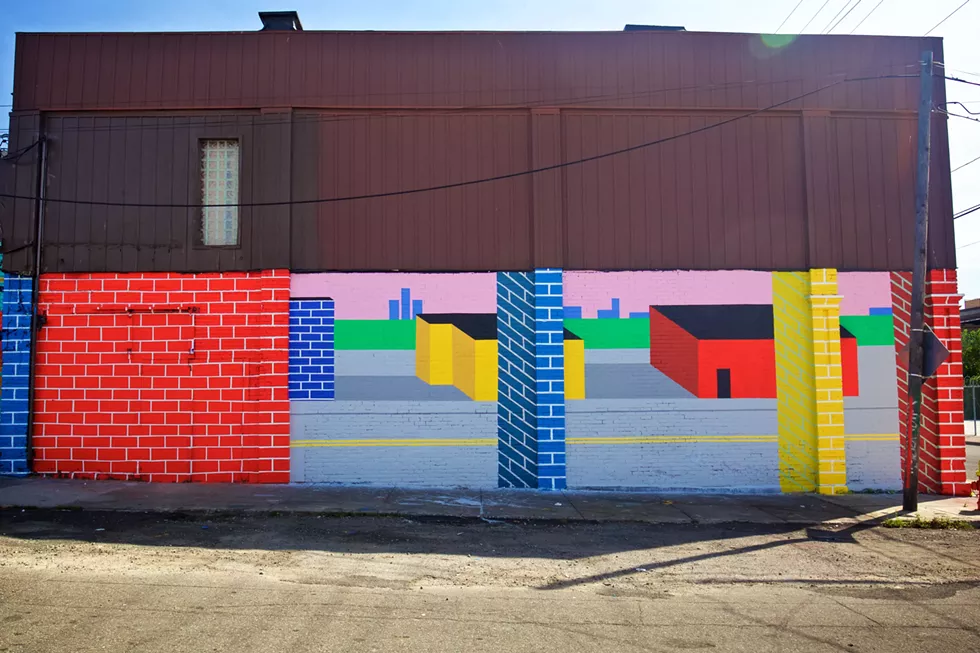
High art
Through aggressive policing and buffing measures, the city has managed to greatly reduce the presence of graffiti. Out-of-town writers, who police say
Writers have also lost a major incentive, in that they are no longer seen.
"It's not going to stick anymore with the buffing happening," says
In that way, the work of what few writers remain is evanescent, and its presence all the more confounding for the general public and police.
"It's ridiculous. It's silly, it's sophomoric," says Detroit Police Lieutenant Rebecca McKay, who commands the unit responsible for catching the graffiti writers. "So many of them are in their late-20s, mid-30s, and they're still doing this — climbing buildings and painting.
"And I'll tell you what — I think that a lot of these artists — vandals," she says, stopping to correct herself, "are true artists and they have true talent. But why are they doing this? It seems like they could be so much more than just a tag on a vacant building."
We positioned the question to WUZN, a 34-year-old who quit painting a few years ago, following two decades in which graffiti was the focal point of his life.
"As a 12-year-old kid, I thought it looked cool and I wanted to be a part of it," he explained. "Then when I was a teenager and I started to wrap my head around why I was doing it, I was like, 'Oh, I'm an introverted, shy person who has a really hard time in public, and it's a way for me to kind of exist everywhere and nowhere at the same time.'
"Then as I got into my late 20s, it was like, 'Oh fuck, I don't know how to transition out of this,' and, 'Oh, I might as well keep doing this because I'm finally good now.'
"Then as you get in your 30s it can go a few different ways. Your life can change and get more stable and you can't risk doing it, or you don't have shit because you've done graffiti your whole life and you just continue to do it because it's all you know how to do.
"The most beautiful part about the whole thing is that the common person cannot wrap their head around why someone would put so much time and effort into something that doesn't give back," he says. "That's why, if you're looking at it
Public art After Death
Detroit is a "city turned canvas," the Detroit Metro Convention & Visitors Bureau tells potential guests on its website. "You don't have to park your car to see breathtaking beauty, it's available — free of admission — on buildings, down alleyways, and from 55 miles per hour."
The art is made possible by the "massive canvas potential in Detroit's changing landscape" and artists who've reclaimed empty spaces, the site says. A tour guide is "quick to tell touring groups the artwork isn't vandalism — as is sometimes the first reaction to spray paint."
The
With street art, "The grassroots — the authentic activity — gets sort of co-opted and tamed, and dressed up for mainstream consumption," says Carducci from CCS.
And it becomes palatable for city government too. Recently, Detroit officials announced they would join the street art wave by investing $50,000 to commission local artists to paint murals throughout the city. The effort, however, is not intended to brighten up Detroit amid the dull buff, it is meant as a crime deterrent: Muralists will be relegated to the spots where the writers won't quit.
And in this way, an art form that is an outgrowth of traditional graffiti has been turned into a weapon to fight it.
"If you were a situationist, you would say this is the recuperation of Detroit. If you were a real hipster, you would say Detroit is over," says Carducci. "[Because] the thing that made Detroit interesting was the fact that there was so much freedom because there was no infrastructure, it was all DIY. For years it was all about what you could get done on your own.
"But it's good to have the trash picked up, its good to have your lights on, it's good to have the police come when you call them instead of waiting three hours. And so, maybe we gotta lose some of the authenticity to have peace of mind. I guess that's the price we pay."

